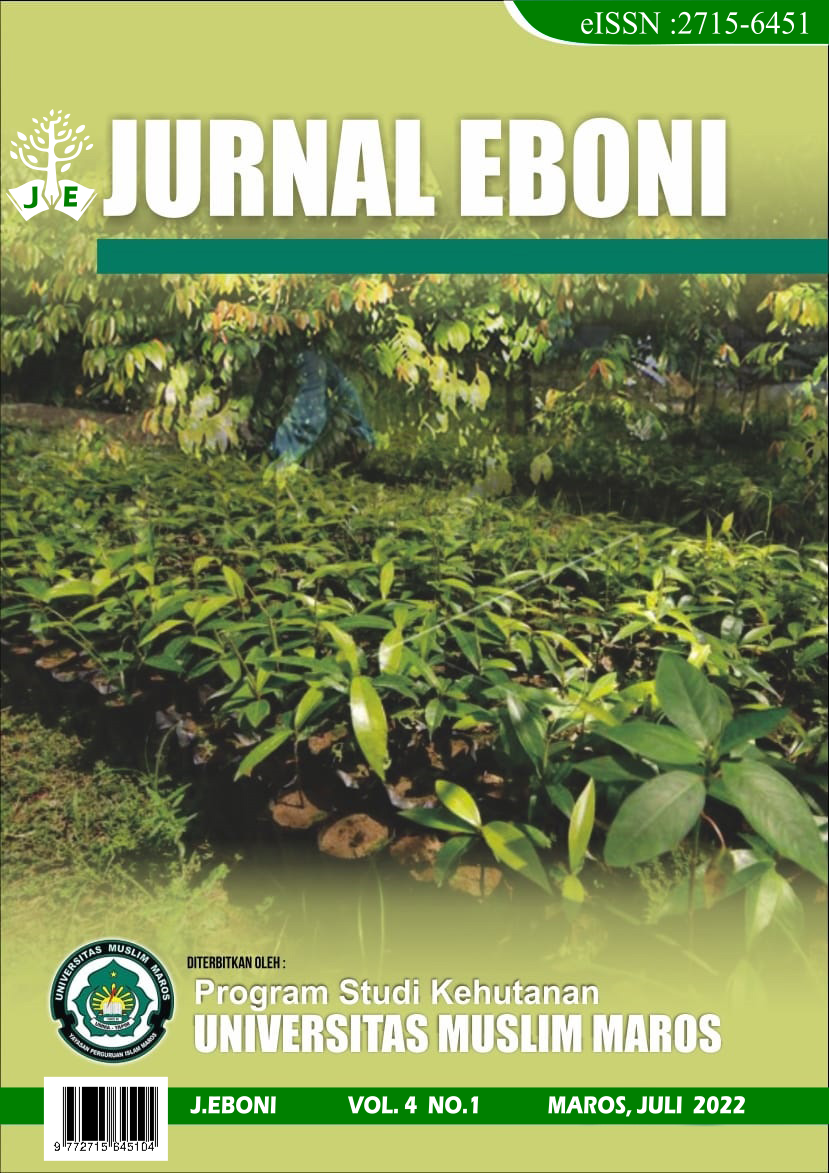EFEKTIVITAS PEMANFAATAN HUTAN KOTA MAROS SEBAGAI RTH PUBLIK DI KELURAHAN PETTUADAE, KECAMATAN TURIKALE, KABUPATEN MAROS
Effectiveness, Utilization, Urban Forest, Public Green Open Space
DOI:
https://doi.org/10.46918/eboni.v4i1.1430Keywords:
Effectiveness, Utilization, Urban Forest, Public Green Open Space.Abstract
This research was carried out in Pettuadae Village, Turikale District, Maros Regency. This location was chosen with the consideration that there is still a lack of research on the effectiveness of the use of urban forests as public green open spaces in Turikale District which is still under-attention so that attention and direct action are needed by the community and the government to control. There are two data used, namely: primary data and secondary data. The objectives of this study were: to determine the utilization of the Maros urban forest as a public green open space and to determine the factors that influence the effectiveness of the use of the urban forest as a public green open space in the Pettuadae village, Turikale sub-district, Maros district. Data were collected from observations, questionnaires, interviews. The collected data was then analyzed. This study uses two methods, namely descriptive analysis method to determine the utilization of urban forest as public green open space and multiple linear regression analysis method to determine the factors that influence the effectiveness of urban forest utilization as public green open space. The results showed that the utilization of Maros urban forest as a public green open space in Pettuadae Village, Turikale District, Maros Regency was effective. where the Maros urban forest is used as a means of gathering for discussions or playing with friends and family, enjoying the beauty of the urban forest and enjoying several sports facilities and can be used for street vendors as a livelihood. The factors that affect the effectiveness of the use of urban forests as public green open space in Pettuadae Village, Turikale District, Maros Regency, namely the effectiveness factors in terms of 4 variables namely regulations, public awareness, availability of public facilities and facilities, and budget support. Where there are only two influential variables, namely public awareness and the availability of public facilities and facilities
References
Anonim, 2013. Inventarisasi Hutan. http:// forester. Untad. Blogspot. Com/ 2013/01/makalah lengkapinventarisasi hutan.
Krisnawati, H., Varis, E., Kallio, M. dan Kanninen, M. 2011. Paraserienthes falcataria (L.) Nielsen: Ekologi, Silvikultur dan produktivitas.CIFOR, Bogor, Indonesia.
Marjenah, 2001. Pengaruh Perbedaan Naungan di Persemaian Terhadap Pertumbuhan dan Respon Morfologi Dua Jenis Semai, Meranti. Jurnal Ilmiah Kehutanan
Nugroho. 1998. Dasar-Dasar Ilmu Statistik Jayakarta.
Samsu, A. K. A. (2019). Pendugaan Potensi Simpanan Karbon Permukaan pada Ruang Terbuka Hijau di Hutan Kota Jompie Kecamatan Soreang Kota Pare-Pare. Jurnal Envisoil, 1(1).
Simon. H. ( 2007). Metode Inventore Hutan. Pustaka Pelajar, Yogyakarta
Wirakusumah, S. 2003. Dasar-dasar Ekologi bagi Populasi dan Komunitas Universitas Indonesia Press. Jakarta.
Widiyanto Ary, M. Siarudin, Encep Rachman. 2013. Pertumbuhan Tujuh Provenan Sengon (Falcataria mollucana) pada Tiga Jarak Tanam. Jurnal Penelitian Agroforestry. Balai Penelitian Teknologi Agroforestry, Badan Penelitian, Pengembangan dan Inovasi. Jakarta
Downloads
Published
Issue
Section
License
Jurnal Eboni © 2019 by LPPM UMMA is licensed under Creative Commons Attribution 4.0 International












9.png)











 : Jl. DR. Samratulangi No.62 Maros 90511 Sulawesi Selatan
: Jl. DR. Samratulangi No.62 Maros 90511 Sulawesi Selatan : https://ejournals.umma.ac.id/index.php/eboni/index
: https://ejournals.umma.ac.id/index.php/eboni/index :
: 